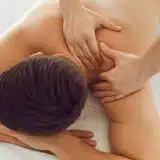Cupping Therapy

Unlocking Ancient Healing: The Revival of Cupping Therapy
What is Massage 10th Aug, 2023
Hailed as an ancient form of alternative medicine, cupping therapy has seen a resurgence in interest in the 21st century, serving as a testament to its enduring relevance in health and wellness. This practice, steeped in a rich historical tradition spanning diverse cultures, entails the use of specially designed cups that are placed on the skin to create a vacuum.
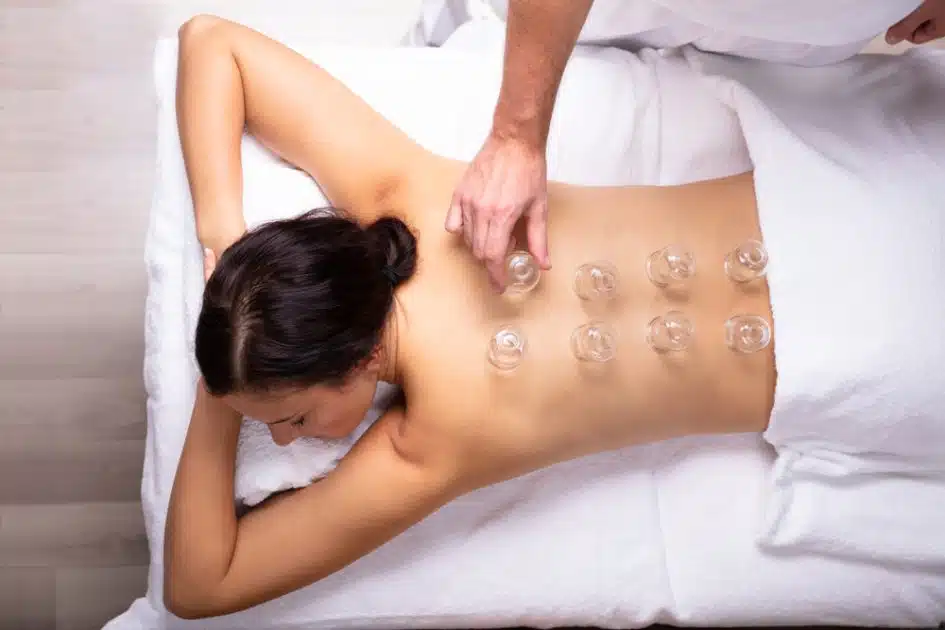
The resulting suction is believed to stimulate the flow of energy, or ‘qi,’ within the body, promoting numerous therapeutic benefits. Known for its ability to alleviate pain, bolster blood circulation, and induce a deep sense of relaxation, cupping therapy has secured its place in the toolbox of complementary therapies.
The appeal of this therapy lies in its non-invasive nature and its potential to restore balance within the body, addressing the root cause of various ailments rather than merely suppressing symptoms.
The Origins of Cupping Therapy
Cupping treatment, while seeing a revival in recent years, is far from a new concept. Its beginnings may be traced back to the chronicles of ancient civilizations that shaped the realm of medicine. Let’s go more into the history of this holistic discipline.
Meanwhile, cupping was used concurrently in ancient China, and it eventually became a fundamental aspect of traditional Chinese medicine. The methodology, advantages, and evolution of cupping treatment are detailed in Chinese medical books spanning numerous dynasties.
The Middle East, with its complex fabric of many cultures and traditions, has its own cupping story. This practice, known in Arabic as “Hijama,” is mentioned in both historical texts and traditional narratives, attesting to its deep-rooted existence in the region.
Materials Throughout History
The cup is fundamental to the practice of cupping, and it can be made of a variety of materials, each of which adds a distinct flavor to the therapy:
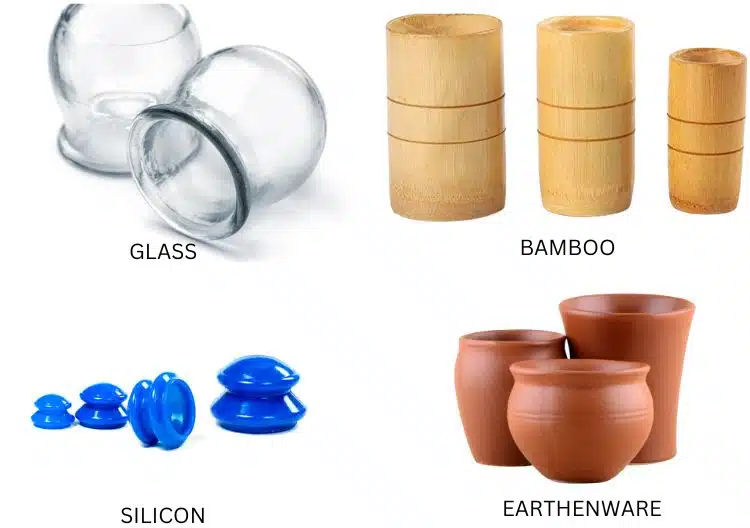
Glass: Because glass cups are transparent, practitioners can observe the skin’s reaction, assuring precision and safety.
Bamboo: Historically significant, particularly in Asian civilizations, bamboo cups are light and durable, and they carry the element of nature with them.
Earthenware: Deeply established in tradition, these ceramic cups inspire a feeling of the old world and are frequently selected for their aesthetic appeal.
Silicone cups are a more recent adaption that is flexible, allowing for more dynamic use, notably in massage-cupping techniques.
Cupping treatment, in essence, is a bridge that connects the wisdom of past civilizations to today’s health and well-being demands. Its prevalence throughout millennia and civilizations attests to its effectiveness and the universal appeal of its therapeutic touch.
We pay gratitude to the ancient civilizations and practitioners that pioneered and conserved this therapeutic jewel while we embrace cupping in the current day.
Cupping Therapy Techniques
Cupping treatment, regarded as an alternative health strategy, encompasses a variety of therapeutic approaches. Each approach has its own complexities, but they all have the same end goal in mind: to promote health and wellness.
Cups are typically kept in place for a few minutes, however, other procedures entail massaging the skin with the cups by moving them over specified locations. Let’s have a look at the main techniques:
Dry Cupping
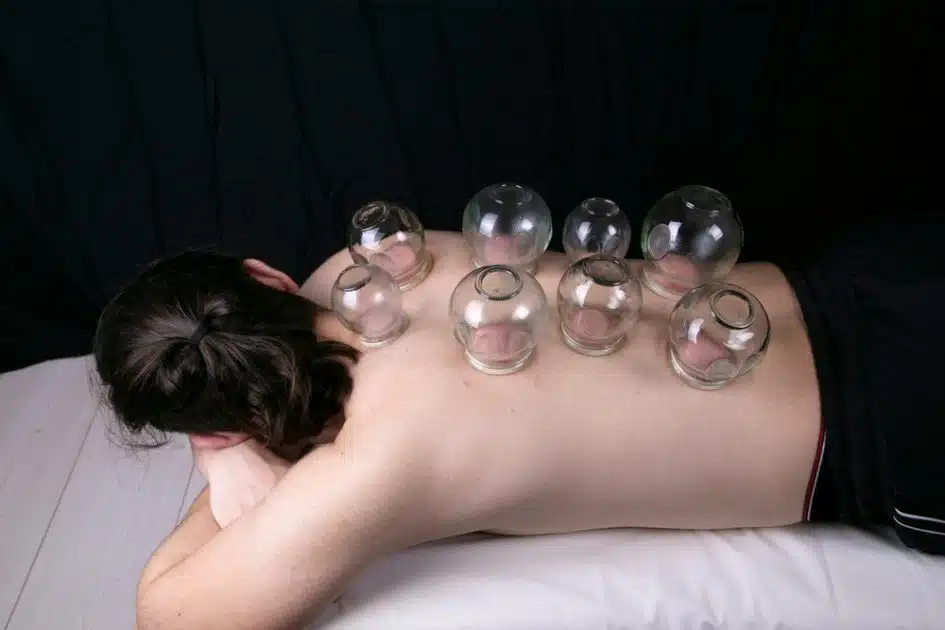
Dry Cupping is the foundation of cupping treatment. It entails heating the inside of each cup, which was historically accomplished by lighting a cotton ball soaked in alcohol. Before the cup is firmly pressed to the skin, a flaming ball is temporarily placed in the cup to produce a vacuum by heat.
Modern techniques have advanced, and a suction device might be used to extract air from the cups, resulting in a vacuum effect. This technological advancement retains the integrity of the ancient process while enhancing safety and precision.
Running Cupping

Running Cupping, also known as sliding or gliding cupping, is performed in the same manner as dry cupping. However, before applying the cup, a coating of oil or lotion is applied to the skin to promote a smooth surface.
After applying heat or suction to the cups, they are gently moved in different directions over the afflicted region, creating a massage-like effect. This action promotes a wider covering area, which improves blood circulation and muscle relaxation.
Bleeding Cupping
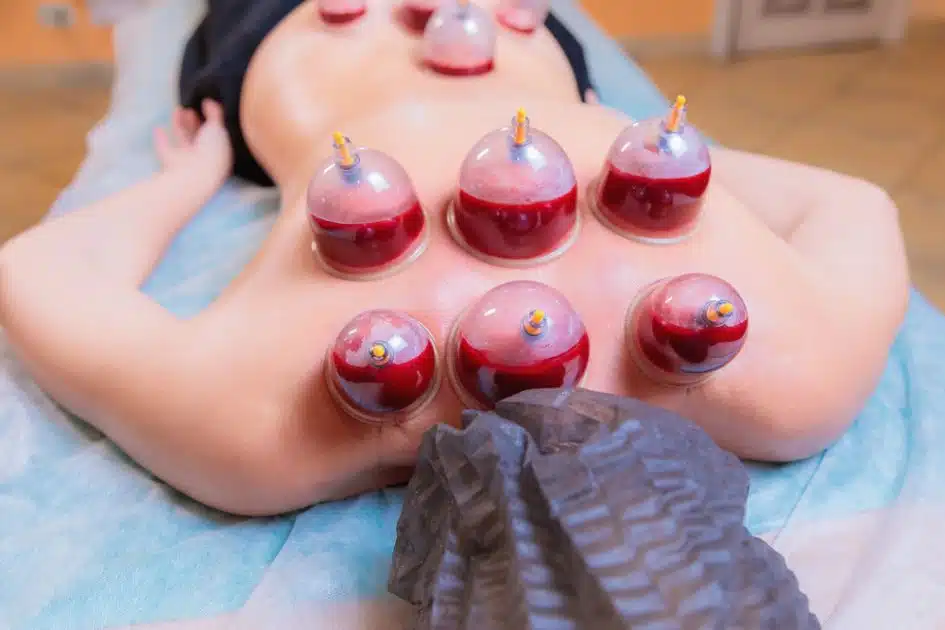
Bleeding Cupping, also known as wet cupping or Hijama, is a technique that includes delicately pricking the skin with a small needle before putting the cups. This procedure suctions a little bit of blood into the cup, which is said to expel toxins from the body.
Despite its scary name, this procedure is performed under sterile settings and is claimed to provide a sensation of cleanliness and regeneration.
The number of cups used varies depending on the technique and the condition of the individual. Typically, therapists use three to five cups. Up to seven cups may be used in more intensive treatments.
Using more than seven cups in a single session, on the other hand, is not typical practice in order to maintain a balanced approach to this therapeutic intervention. To summarize, the numerous cupping treatment procedures serve to a wide range of individual requirements and problems, each offering a distinct experience within this age-old therapeutic journey.
Potential Side Effects and Risks of Cupping Therapy
While cupping therapy is typically safe and useful, it is vital to recognize the potential side effects and hazards of this ancient procedure. These might vary depending on the type of cupping therapy used and the individual’s condition. As with any medical procedure, informed consent is essential, as is understanding of potential discomfort or problems.
Potential Side Effects: Temporary and Manageable
Although cupping therapy is typically well tolerated, it is not unusual for individuals to encounter some post-procedure negative effects. These might include:
1. Mild Discomfort
Some people may experience a slight pulling sensation during cupping, which usually subsides after the session. It’s important to inform your therapist if the discomfort escalates beyond a tolerable level.
2. Bruises
The vacuum created by the cups can cause small blood vessels in the skin to rupture, leading to circular bruises. Though these might be visually striking, they typically fade within a week or two.
3. Burns
If a practitioner uses heat to create suction in the cups, there is a risk of minor burns. To minimize this risk, ensure your therapist is experienced and has been properly trained.
4. Skin Infection
Although rare, skin infections can occur if cups are not properly cleaned or if post-care instructions are not properly followed. Practitioners should always use sterilized equipment, and patients should keep the cupped areas clean after the session.
5. Spread of Bloodborne Diseases
This is primarily a concern with wet cupping, where the skin is punctured and blood is drawn. If equipment is not adequately sterilized between patients, there could be a risk of spreading diseases like hepatitis B and C. However, this risk is minimal when treatment is provided by a qualified and conscientious practitioner.
Potential Complications: Rare but Relevant
Although cupping treatment is typically regarded as a low-risk practice, problems might occur. These are some examples:
1. Fatigue
Post-session fatigue is common as the body recalibrates itself. This should be temporary and usually resolves within a day or two.
2. Headaches and Muscle Tension
The release of toxins or the physical manipulation of soft tissue can sometimes trigger headaches or muscle tension. Drinking plenty of water and rest can help to alleviate these symptoms.
3. Nausea
Some individuals may experience a sense of nausea after cupping, particularly after their initial session. This is typically temporary and may be relieved by rest and hydration.
4. Vasovagal Syncope
In rare cases, individuals might experience a fainting episode or lightheadedness due to a drop in blood pressure and heart rate, particularly following wet cupping if they are prone to fainting with needle sticks.
5. Skin Infections, Itching, or Scarring
As mentioned, these risks can be minimized by ensuring sterile conditions and following post-care instructions.
To summarize, while cupping treatment has numerous potential health advantages, it is critical to be aware of any side effects and hazards. To guarantee the safest and most effective experience, always have your cupping sessions performed by a well-trained and recognized practitioner.
Benefits of Cupping Therapy
Cupping treatment has been praised for centuries for its wide range of advantages, providing relief from a wide range of health issues. It provides a unique mix of physical and mental advantages through the use of targeted suction. Let’s look at the most often mentioned benefits of this therapy:
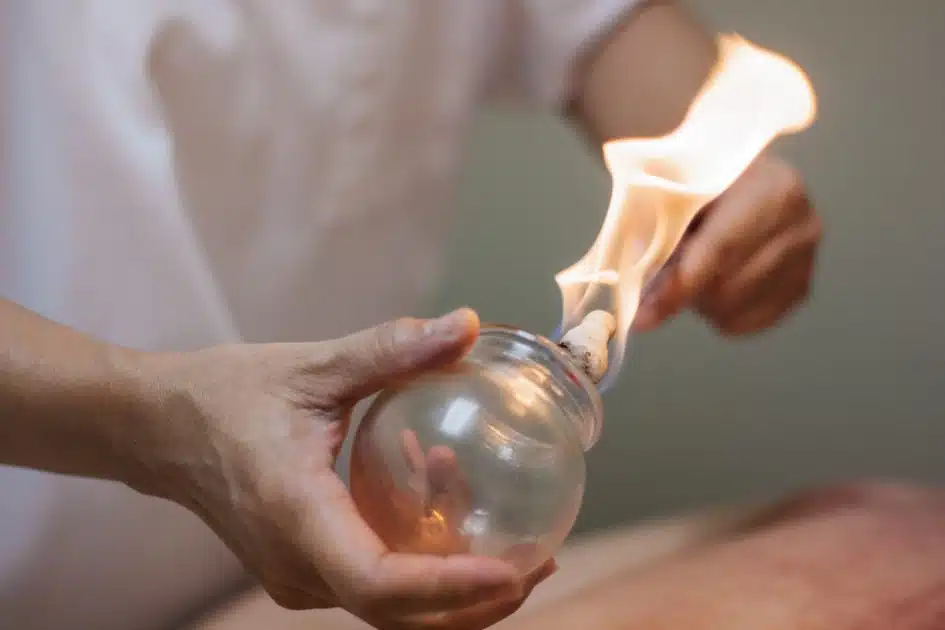
1. Pain Reduction
Cupping treatment is frequently used to alleviate pain. The suction formed by the cups can assist in increasing blood flow to the damaged area, therefore speeding up the body’s natural healing processes. This makes it especially useful for people suffering from illnesses like lower back pain, migraines, or arthritis.
2. Decreased Inflammation
Cupping can assist to decrease inflammation by improving circulation and stimulating the body to produce new vascular tissue. Inflammation is the body’s response to injury or sickness. As a result, it has the potential to be a useful therapy for inflammatory illnesses such as rheumatoid arthritis and fibromyalgia.
3. Muscle Relaxation
During a cupping session, the application and movement of the cups might help to relax stiff muscles. The technique works similarly to a deep tissue massage, releasing muscles and alleviating pain and suffering.
4. Enhanced Blood Flow
Enhancing blood flow in the body is one of the primary concepts of cupping treatment. Cupping pulls blood to the skin’s surface by generating a vacuum, stimulating the circulatory system, and helping to nourish the body and improve organ and tissue function.
5. Increased Range of Motion
Cupping can assist to increase flexibility and range of motion by relaxing muscles, alleviating stiffness, and lowering inflammation. This is especially useful for athletes who are recovering from injuries or surgery.
6. Boosted Immune System
By increasing blood circulation and promoting the disposal of toxins, cupping therapy can potentially boost the immune system. Improved circulation enables better distribution of nutrients and quicker removal of waste products, strengthening the body’s defense mechanisms against illness.
7. Mental Relaxation
The cupping treatment provides mental and emotional benefits in addition to physical benefits. Similar to massage or meditation, the procedure can induce a deep sensation of relaxation and stress alleviation. This may be especially good for people coping with mental health issues like anxiety and depression, as well as those looking to reduce daily stress.
While these advantages make cupping therapy an appealing therapeutic choice, it is important to emphasize that individual experiences and outcomes may differ. Furthermore, scientific study into the efficacy of cupping therapy is continuing, thus it should be seen as a supplemental treatment rather than a cure in its own right. Before beginning any new treatment program, it is always best to consult with a healthcare expert.
Who Should Avoid Cupping Therapy?
While cupping treatment has a number of potential benefits, it’s important to remember that it’s not for everyone. Because certain health issues might increase the risk of complications, patients diagnosed with the following diseases should typically avoid cupping therapy:
1. Anemia
Individuals with anemia, a condition characterized by a deficiency of red cells or hemoglobin in the blood, should generally avoid cupping therapy. The therapy might potentially exacerbate the symptoms of anemia, including fatigue and weakness.
2. Pacemaker
For those with a cardiac pacemaker, cupping therapy might pose risks. The suction from cupping could potentially interfere with the function of the pacemaker, which can lead to heart rhythm complications.
3. Hemophilia or Other Bleeding Disorders
Individuals with bleeding disorders like hemophilia, characterized by an impaired ability of the blood to clot, should avoid cupping, especially wet cupping, which involves making small incisions on the skin.
4. Blood Clotting Problems
Cupping therapy can increase the risk of dislodging a blood clot, especially in those with a history of deep vein thrombosis (DVT) or strokes. If a clot is dislodged, it can travel to the lungs, heart, or brain, causing serious health complications.
5. Cardiovascular Disease
Individuals suffering from cardiovascular disease should also exercise caution as cupping therapy could potentially increase the load on the heart.
6. Skin Conditions
People with skin conditions like eczema and psoriasis might experience worsening symptoms following cupping therapy, due to the direct contact of the cups with the skin.
7. Seizures (Epilepsy)
Those with epilepsy, a neurological disorder marked by sudden recurrent episodes of sensory disturbance or convulsive seizures, might also be advised to avoid cupping therapy.
Additionally, given the limited research on cupping’s effects on pregnancy, it’s generally advised that pregnant individuals avoid cupping therapy to prevent any unforeseen complications.
Although cupping therapy is considered a low-risk treatment, these considerations highlight the importance of professional medical advice before beginning any new treatment regimen. Always consult with a trained healthcare provider who understands your medical history and can guide you in making informed decisions about your health. And remember, while cupping therapy can complement traditional treatments, it should not replace conventional medical care or medication.
Recommended:
Medical Massage Therapy
The Bottom Line
Cupping therapy, an ancient technique from old cultures, is still widely used in alternative medicine. It uses suction to provide benefits like pain relief, improved blood flow, and relaxation. However, its effectiveness varies depending on the individual and condition. While recent studies show some positive results, more scientific research is needed to fully understand these benefits.
It’s important to be aware that cupping therapy, like any treatment, has potential risks such as discomfort, bruising, and in rare cases, serious side effects like burns or skin infections. Therefore, it’s essential to consult a trained professional before considering cupping therapy.
FAQs
Is cupping good or bad for you?
Cupping can be beneficial for many, but its effects vary. Always consult a health professional before trying.
What are the side effects of cupping?
Side effects may include mild discomfort, burns, bruises, and skin infections.
Why can’t you shower after cupping?
Showering immediately can alter the therapeutic effects and may irritate the cupped areas.
When should you not use cupping?
Avoid cupping if pregnant or if you have conditions like anemia, pacemakers, certain skin conditions, or blood disorders.
How many hours you can take a bath after Ventosa?
It’s recommended to wait at least 24 hours after a Ventosa session before bathing.













